B-hCD200/hCD200R mice
| Strain Name |
C57BL/6-Cd200tm1(CD200)Bcgen Cd200r1tm1(CD200R1)Bcgen/Bcgen
|
Common Name | B-hCD200/hCD200R mice |
| Background | C57BL/6 | Catalog number | 111888 |
| Aliases |
CD200, MOX1, MOX2, MRC, OX-2, CD200 molecule; CD200R1, CD200R, HCRTR2, MOX2R, OX2R, CD200 receptor 1 |
||
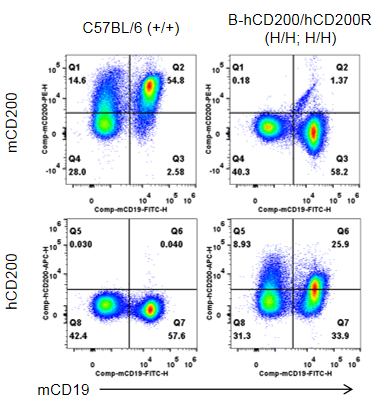
Strain specific CD200 expression analysis in homozygous B-hCD200/hCD200R mice by flow cytometry. Splenocytes were collected from wild type (WT) mice (+/+) and homozygous B-hCD200/hCD200R mice (H/H; H/H), and analyzed by flow cytometry with species-specific anti-CD200 antibody. Mouse CD200 was detectable in WT mice (+/+). Human CD200 was exclusively detectable in homozygous B-hCD200/hCD200R mice (H/H;H/H) but not in WT mice (+/+).
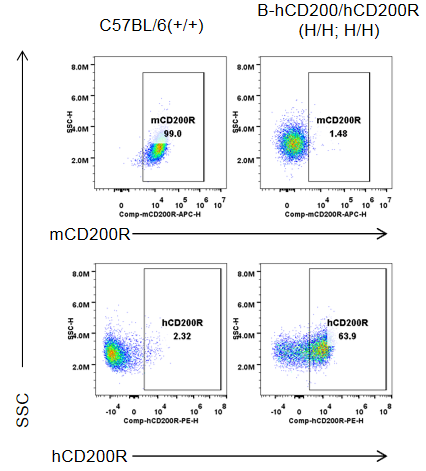
Strain specific CD200R expression analysis in homozygous B-hCD200/hCD200R mice by flow cytometry. Peritoneal exudative macrophages were collected from wild type (WT) mice (+/+) and homozygous B-hCD200/hCD200R mice (H/H; H/H), and analyzed by flow cytometry with species-specific anti-CD200R antibody. Mouse CD200R was detectable in WT mice (+/+). Human CD200R was exclusively detectable in homozygous B-hCD200/hCD200R mice (H/H; H/H) but not in WT mice (+/+).

Analysis of spleen leukocyte subpopulations by FACS.Splenocytes were isolated from female C57BL/6 and B-hCD200/hCD200R mice (n=3, 8 week-old). Flow cytometry analysis of the splenocytes was performed to assess leukocyte subpopulations. A. Representative FACS plots. Single live cells were gated for CD45 population and used for further analysis as indicated here. B. Results of FACS analysis. Percent of T cells, B cells, NK cells, dendritic cells, granulocytes, monocytes and macrophages in homozygous B-hCD200/hCD200R mice were similar to those in the C57BL/6 mice, demonstrating that introduction of hCD200/hCD200R in place of its mouse counterpart does not change the overall development, differentiation or distribution of these cell types in spleen. Values are expressed as mean ± SEM.
Analysis of spleen T cell subpopulations in B-hCD200/hCD200R mice
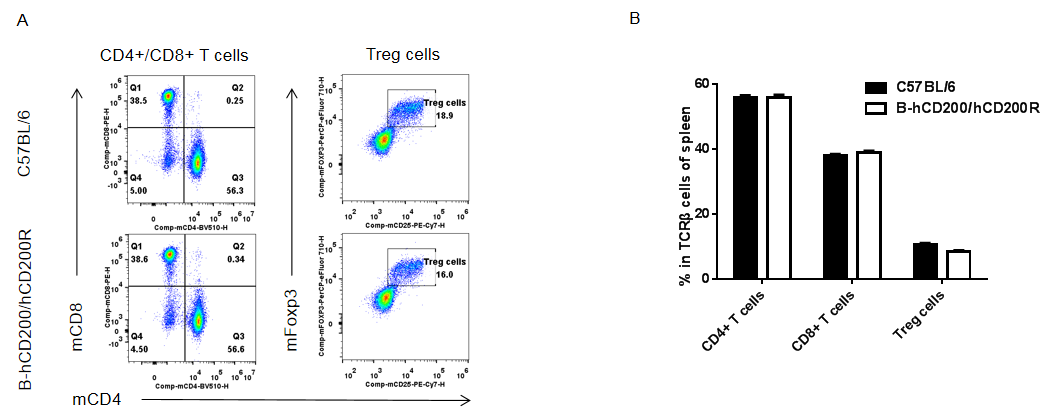
Analysis of spleen T cell subpopulations by FACS.Splenocytes were isolated from female C57BL/6 and B-hCD200/hCD200R mice (n=3, 8 week-old). Flow cytometry analysis of the splenocytes was performed to assess T cell subsets. A. Representative FACS plots. Single live CD45+ cells were gated for CD3 T cell population and used for further analysis as indicated here. B. Results of FACS analysis. Percent of CD8+ T cells, CD4+ T cells and Treg cells in homozygous B-hCD200/hCD200R mice were similar to those in the C57BL/6 mice, demonstrating that introduction of hCD200/hCD200R in place of its mouse counterpart does not change the overall development, differentiation or distribution of these T cell sub types in spleen. Values are expressed as mean ± SEM.

Analysis of lymph node leukocyte subpopulations by FACS.Leukocytes were isolated from female C57BL/6 and B-hCD200/hCD200R mice (n=3, 8 week-old). Flow cytometry analysis of the leukocytes was performed to assess leukocyte subpopulations. A. Representative FACS plots. Single live cells were gated for CD45 population and used for further analysis as indicated here. B. Results of FACS analysis. Percent of T cells, B cells and NK cells in homozygous B-hCD200/hCD200R mice were similar to those in the C57BL/6 mice, demonstrating that introduction of hCD200/hCD200R in place of its mouse counterpart does not change the overall development, differentiation or distribution of these cell types in lymph node. Values are expressed as mean ± SEM.
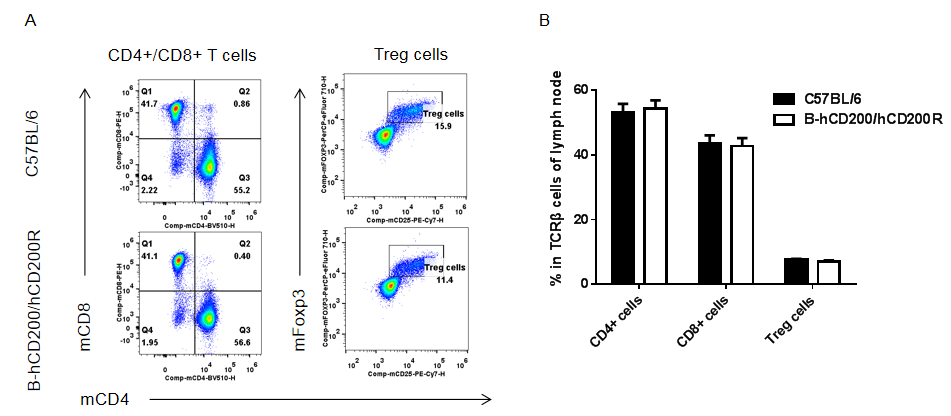
Analysis of lymph node T cell subpopulations by FACS.Leukocytes were isolated from female C57BL/6 and B-hCD200/hCD200R mice (n=3, 8 week-old). Flow cytometry analysis of the leukocytes was performed to assess T cell subsets. A. Representative FACS plots. Single live CD45+ cells were gated for CD3 T cell population and used for further analysis as indicated here. B. Results of FACS analysis. Percent of CD8+ T cells, CD4+ T cells and Treg cells in homozygous B-hCD200/hCD200R mice were similar to those in the C57BL/6 mice, demonstrating that introduction of hCD200/hCD200R in place of its mouse counterpart does not change the overall development, differentiation or distribution of these T cell sub types in lymph node. Values are expressed as mean ± SEM.
In vivo efficacy of anti-hCD200 antibody combined with anti-mPD-1 antibody
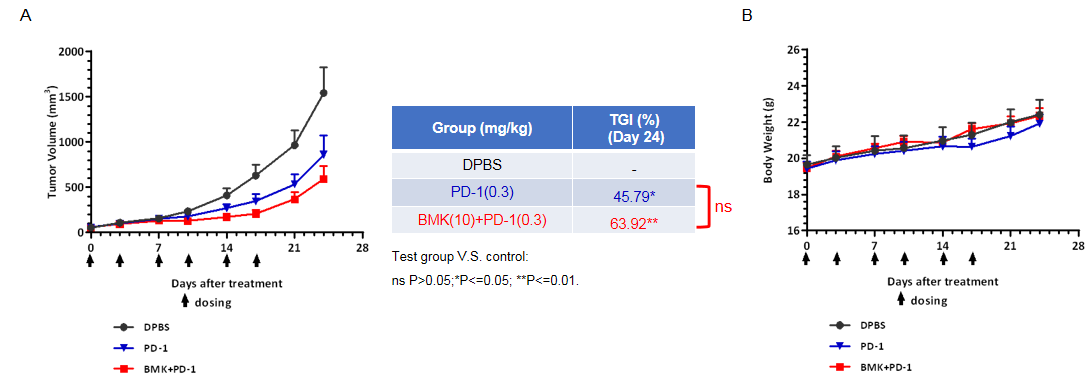
In vivo antitumor activity of anti-human CD200 (hCD200) antibody when used in combination with anti-mouse PD-1 (mPD-1) antibody. Murine colon cancer B-hCD200 MC38 cells (5x105) were subcutaneously implanted into homozygous B-hCD200/hCD200R mice (female, 6-8-week-old, n=6). Mice were grouped when tumor volume reached approximately 100 mm3, at which time they were intraperitoneally injected with DPBS, anti-mPD-1 antibody alone or in combination with anti-hCD200 antibody BMK (provided by a client). (A) Anti-hCD200 antibody combination with anti-mPD-1 antibody inhibited B-hCD200 MC38 tumor growth in B-hCD200/hCD200R mice. (B) Body weight changes during treatment. As shown in panel A, anti-hCD200 antibody combination with anti-mPD-1 antibody was efficacious in controlling tumor growth in B-hCD200/hCD200R mice, demonstrating that the B-hCD200/hCD200R mice provide a powerful preclinical model for in vivo evaluation of anti-human CD200 antibodies. Values are expressed as mean ± SEM. Significance was determined by two-way ANOVA test. ns P>0.05;*P<=0.05; **P<=0.01.
Note:This data comes from a client.












 京公网安备:
京公网安备: